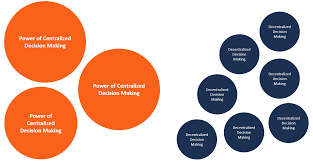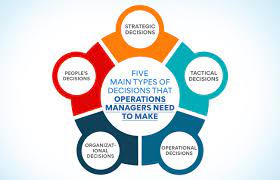The Mintzberg Decision Making Model: A Practical Approach to Effective Decision Making
In the world of business, decision making is a critical skill that can greatly impact the success or failure of an organization. With numerous decisions to be made on a daily basis, it becomes essential to have a structured approach that can help leaders navigate through the complexity and uncertainty of the decision-making process. One such approach is the Mintzberg Decision Making Model.
Developed by renowned management expert Henry Mintzberg, this model provides a practical framework for making effective decisions in various contexts. It recognizes that decision making is not a linear process but rather a complex interplay of multiple factors. Let’s delve into the key elements of this model and how it can enhance your decision-making abilities.
Identify the Problem:
The first step in the Mintzberg Decision Making Model is to clearly define and identify the problem at hand. This involves understanding the underlying issues, gathering relevant information, and analyzing the root causes. By gaining a comprehensive understanding of the problem, you can lay a solid foundation for effective decision making.
Generate Alternatives:
Once you have identified the problem, it’s time to brainstorm and generate multiple alternatives or solutions. The emphasis here is on divergent thinking, encouraging creativity and exploring various possibilities. This step helps broaden your perspective and ensures that you consider different options before narrowing down your choices.
Evaluate Options:
After generating alternatives, it’s crucial to evaluate each option based on its feasibility, potential risks, benefits, and alignment with organizational goals. This evaluation should be done objectively using relevant criteria or frameworks to ensure an unbiased assessment of each alternative.
Choose an Option:
Having evaluated all available options, it’s time to make a decision and choose one that best addresses the identified problem or challenge. The selection should be based on careful consideration of all relevant factors while keeping in mind potential consequences and long-term implications.
Implement the Decision:
Once a decision has been made, the next step is to put it into action. This involves creating an action plan, allocating resources, and communicating the decision to all relevant stakeholders. Effective implementation requires clear direction, effective coordination, and ongoing monitoring to ensure that the desired outcomes are achieved.
Evaluate the Outcome:
The final step in the Mintzberg Decision Making Model is to evaluate the outcome of the decision. This involves assessing whether the chosen option has effectively addressed the identified problem or if any adjustments need to be made. Learning from both successful and unsuccessful decisions helps refine your decision-making skills and improves future outcomes.
The Mintzberg Decision Making Model provides a structured yet flexible approach that acknowledges the complexities of decision making in real-world scenarios. By following this model, leaders can enhance their ability to make informed decisions that align with organizational goals and drive positive results.
Remember, effective decision making is an ongoing process that requires continuous learning, adaptation, and refinement. By incorporating the principles of the Mintzberg Decision Making Model into your decision-making practices, you can navigate through challenges with greater confidence and increase your chances of achieving success in today’s dynamic business landscape.
Commonly Asked Questions about Mintzberg’s Decision Making Model
- What are the 3 types of decision making?
- What are the Mintzberg’s 5 P’s of strategy?
- What are the 5 types of decision making?
- What are Mintzberg 10 schools of strategy?
What are the 3 types of decision making?
There are generally three types of decision making:
- Routine or Programmed Decision Making: These are decisions that are made in repetitive and well-defined situations. They follow established rules, procedures, or guidelines. Routine decisions are usually based on past experiences and require minimal effort or cognitive processing. Examples include following a standard operating procedure, ordering routine supplies, or approving routine requests.
- Tactical or Administrative Decision Making: Tactical decisions are made by middle-level managers to address specific operational issues within an organization. These decisions are moderately complex and require some analysis and judgment. They often involve allocating resources, setting short-term goals, and coordinating activities to achieve organizational objectives. Tactical decision making helps bridge the gap between strategic decisions (made by top-level management) and operational execution.
- Strategic Decision Making: Strategic decisions are high-stakes choices made by top-level executives that have a significant impact on the long-term direction and success of an organization. These decisions typically involve analyzing complex information, considering multiple alternatives, assessing risks and uncertainties, and aligning with the organization’s mission, vision, and values. Examples of strategic decisions include entering new markets, adopting new technologies, mergers and acquisitions, or major investments.
It’s important to note that these types of decision making exist on a continuum rather than being mutually exclusive categories. Many decisions may fall somewhere in between these types depending on their complexity, time frame, and importance to the organization. Effective decision makers understand the nature of each type of decision making and apply appropriate approaches accordingly to achieve desired outcomes.
What are the Mintzberg’s 5 P’s of strategy?
Mintzberg’s 5 P’s of strategy are a framework developed by Henry Mintzberg, a renowned management thinker, to understand and analyze the components of a strategic plan. These 5 P’s provide a comprehensive view of what constitutes a strategy. Let’s explore each element in detail:
- Plan: The first “P” refers to the formalized plan or intended course of action that an organization develops to achieve its goals. It involves setting objectives, outlining strategies, and creating a roadmap for implementation. The plan provides direction and serves as a blueprint for decision making.
- Ploy: This element focuses on the specific tactics and maneuvers employed by an organization to gain a competitive advantage. Ploys involve actions such as pricing strategies, marketing campaigns, alliances, or any deliberate move aimed at outmaneuvering competitors or influencing market dynamics.
- Pattern: Patterns refer to the consistency or recurring themes observed in an organization’s actions over time. By analyzing past behaviors and decisions, patterns can emerge that indicate the organization’s preferred way of operating or responding to various situations. Identifying patterns helps understand an organization’s strategic tendencies and core competencies.
- Position: Positioning involves determining how an organization distinguishes itself from competitors in the marketplace. It encompasses factors such as target market selection, product differentiation, pricing strategy, and brand positioning. A strong position allows an organization to carve out a unique space in customers’ minds and create sustainable competitive advantage.
- Perspective: Perspective refers to the collective mindset, values, beliefs, and culture within an organization that influences its strategic choices and decision-making processes. It reflects the shared understanding of what the organization stands for and how it views itself in relation to its environment.
It is important to note that these 5 P’s are not meant to be viewed in isolation but rather as interconnected elements that collectively shape an organization’s strategy. They provide a holistic perspective on the various dimensions that need to be considered when formulating and implementing a strategic plan.
By analyzing and understanding these 5 P’s, organizations can gain insights into their strategic positioning, identify areas for improvement, and make informed decisions that align with their long-term goals.
What are the 5 types of decision making?
There are various types of decision making that individuals and organizations employ based on the nature of the decision and the context in which it is made. Here are five common types of decision making:
Rational Decision Making:
Rational decision making follows a systematic and logical approach. It involves gathering relevant information, analyzing alternatives, evaluating risks and benefits, and selecting the best option based on objective criteria. This type of decision making aims to maximize outcomes by considering all available information.
Intuitive Decision Making:
Intuitive decision making relies on gut feelings, instincts, and past experiences. It involves quick assessments of situations without necessarily following a step-by-step analysis. Intuition can be valuable when facing time constraints or dealing with complex or ambiguous situations where there may not be enough data to make a rational decision.
Collaborative Decision Making:
Collaborative decision making involves involving multiple stakeholders or team members in the decision-making process. It emphasizes gathering diverse perspectives, sharing information, and seeking consensus or agreement among the participants. This approach fosters teamwork, enhances creativity, and increases buy-in from those affected by the decision.
Incremental Decision Making:
Incremental decision making is characterized by making small adjustments or changes over time rather than implementing significant or radical shifts immediately. This approach allows for flexibility, learning from previous decisions, and adapting strategies based on feedback received during implementation.
Bounded Rationality Decision Making:
Bounded rationality recognizes that humans have limitations in processing information and often make decisions based on simplified models or heuristics due to time constraints or cognitive biases. In this type of decision making, individuals aim to achieve satisfactory outcomes rather than optimal ones given the constraints they face.
It’s important to note that these types of decision making are not mutually exclusive, and different situations may call for different approaches or a combination thereof. Effective decision makers are adaptable and can choose the most appropriate type of decision-making process based on the specific circumstances they encounter.
What are Mintzberg 10 schools of strategy?
Henry Mintzberg, a renowned management scholar, proposed ten schools of thought on strategy development. These schools represent different perspectives and approaches to strategic management. Let’s explore each of these schools briefly:
The Design School:
This school views strategy development as a formal process led by top management. It emphasizes the importance of analysis, planning, and setting clear objectives to achieve competitive advantage.
The Planning School:
Similar to the Design School, this school focuses on formal strategic planning processes. It emphasizes the role of systematic analysis and forecasting in developing strategies.
The Positioning School:
This school emphasizes finding a unique and defensible position in the market. It suggests that organizations should focus on identifying opportunities for differentiation and competitive advantage.
The Entrepreneurial School:
The Entrepreneurial School highlights the role of visionary leaders in shaping strategies based on their own intuition and personal beliefs. It encourages taking risks and seizing opportunities.
The Cognitive School:
This school recognizes that individual perceptions, beliefs, and mental models influence strategic decision making. It emphasizes understanding how managers interpret information and make sense of complex situations.
The Learning School:
The Learning School promotes continuous learning through experimentation, adaptation, and feedback loops. It suggests that strategies emerge through trial-and-error learning rather than being pre-determined.
The Power School:
This school focuses on how power dynamics within organizations shape strategy development processes. It acknowledges that strategy decisions are influenced by political interests and conflicts among stakeholders.
The Cultural School:
The Cultural School emphasizes the role of organizational culture in shaping strategy development processes. It suggests that shared values, beliefs, and norms influence strategic choices.
The Environmental School:
This school emphasizes the impact of external factors such as industry trends, competitive forces, and market dynamics on strategy development processes.
The Configuration or Mintzberg’s 5Ps Model:
The Configuration or 5Ps Model integrates various perspectives from the other schools. It suggests that strategy development should consider five key elements: Plan, Ploy, Pattern, Position, and Perspective.
It’s important to note that these schools are not mutually exclusive but rather represent different lenses through which strategic management can be understood. Organizations may adopt a combination of these perspectives depending on their context and objectives.
By understanding these ten schools of strategy, managers can gain insights into different approaches to strategic thinking and decision making, enabling them to develop more effective strategies for their organizations.



